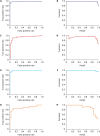Prediction of Neurological Outcomes in Out-of-hospital Cardiac Arrest Survivors Immediately after Return of Spontaneous Circulation: Ensemble Technique with Four Machine Learning Models
- PMID: 34282605
- PMCID: PMC8289719
- DOI: 10.3346/jkms.2021.36.e187
Prediction of Neurological Outcomes in Out-of-hospital Cardiac Arrest Survivors Immediately after Return of Spontaneous Circulation: Ensemble Technique with Four Machine Learning Models
Abstract
Background: We performed this study to establish a prediction model for 1-year neurological outcomes in out-of-hospital cardiac arrest (OHCA) patients who achieved return of spontaneous circulation (ROSC) immediately after ROSC using machine learning methods.
Methods: We performed a retrospective analysis of an OHCA survivor registry. Patients aged ≥ 18 years were included. Study participants who had registered between March 31, 2013 and December 31, 2018 were divided into a develop dataset (80% of total) and an internal validation dataset (20% of total), and those who had registered between January 1, 2019 and December 31, 2019 were assigned to an external validation dataset. Four machine learning methods, including random forest, support vector machine, ElasticNet and extreme gradient boost, were implemented to establish prediction models with the develop dataset, and the ensemble technique was used to build the final prediction model. The prediction performance of the model in the internal validation and the external validation dataset was described with accuracy, area under the receiver-operating characteristic curve, area under the precision-recall curve, sensitivity, specificity, positive predictive value (PPV), and negative predictive value (NPV). Futhermore, we established multivariable logistic regression models with the develop set and compared prediction performance with the ensemble models. The primary outcome was an unfavorable 1-year neurological outcome.
Results: A total of 1,207 patients were included in the study. Among them, 631, 139, and 153 were assigned to the develop, the internal validation and the external validation datasets, respectively. Prediction performance metrics for the ensemble prediction model in the internal validation dataset were as follows: accuracy, 0.9620 (95% confidence interval [CI], 0.9352-0.9889); area under receiver-operator characteristics curve, 0.9800 (95% CI, 0.9612-0.9988); area under precision-recall curve, 0.9950 (95% CI, 0.9860-1.0000); sensitivity, 0.9594 (95% CI, 0.9245-0.9943); specificity, 0.9714 (95% CI, 0.9162-1.0000); PPV, 0.9916 (95% CI, 0.9752-1.0000); NPV, 0.8718 (95% CI, 0.7669-0.9767). Prediction performance metrics for the model in the external validation dataset were as follows: accuracy, 0.8509 (95% CI, 0.7825-0.9192); area under receiver-operator characteristics curve, 0.9301 (95% CI, 0.8845-0.9756); area under precision-recall curve, 0.9476 (95% CI, 0.9087-0.9867); sensitivity, 0.9595 (95% CI, 0.9145-1.0000); specificity, 0.6500 (95% CI, 0.5022-0.7978); PPV, 0.8353 (95% CI, 0.7564-0.9142); NPV, 0.8966 (95% CI, 0.7857-1.0000). All the prediction metrics were higher in the ensemble models, except NPVs in both the internal and the external validation datasets.
Conclusion: We established an ensemble prediction model for prediction of unfavorable 1-year neurological outcomes in OHCA survivors using four machine learning methods. The prediction performance of the ensemble model was higher than the multivariable logistic regression model, while its performance was slightly decreased in the external validation dataset.
Keywords: Cardiopulmonary Resuscitation; Heart Arrest; Machine Learning.
© 2021 The Korean Academy of Medical Sciences.
Conflict of interest statement
The authors have no potential conflicts of interest to disclose.
Figures


References
-
- Hawkes C, Booth S, Ji C, Brace-McDonnell SJ, Whittington A, Mapstone J, et al. Epidemiology and outcomes from out-of-hospital cardiac arrests in England. Resuscitation. 2017;110:133–140. - PubMed
-
- Virani SS, Alonso A, Benjamin EJ, Bittencourt MS, Callaway CW, Carson AP, et al. Heart disease and stroke statistics-2020 update: a report from the American Heart Association. Circulation. 2020;141(9):e139–e596. - PubMed
-
- Nolan JP, Soar J, Cariou A, Cronberg T, Moulaert VR, Deakin CD, et al. European resuscitation council and European society of intensive care medicine guidelines for post-resuscitation care 2015: section 5 of the European resuscitation council guidelines for resuscitation 2015. Resuscitation. 2015;95:202–222. - PubMed
-
- Panchal AR, Bartos JA, Cabanas JG, Donnino MW, Drennan IR, Hirsch KG, et al. Part 3: adult basic and advanced life support: 2020 American Heart Association guidelines for cardiopulmonary resuscitation and emergency cardiovascular care. Circulation. 2020;142(16_) suppl_2:S366–S468. - PubMed
MeSH terms
LinkOut - more resources
Full Text Sources
Medical

